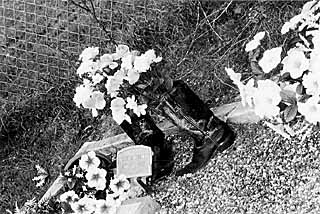Grave Importance
Cemeteries Provide Respite From Daily Life
By Meiling Guentzel, Fri., Oct. 27, 2000

Last night, I killed my mom. She kept insisting that I wasn't capable of flipping her over my shoulder. I assured her that I had the strength, and that if I chose to do it, it would end her life. She maintained her ground.
"No, no," she insisted.
I warned again. "It'll kill you."

She refused to believe me.
"Try it," she taunted. "It won't work."
I flared with frustration, then did it. I flipped my mother over my shoulder, and sure enough, she died.
Some dream analysts say that death symbolizes change. See, earlier this week, I had revealed to my mother how much one particular habit of hers truly irked me. As I slept that evening, my subconscious took over, emphasizing the meaning of my actions. I awoke the next morning with a sharp sense of how much I'd tried to kill ... er, change my mom.

Change.
Death.
The mingling of these two concepts intrigues me, which may explain my fondness of cemeteries. Strange as it is to my friends and family, I visit burial grounds during my free time. I take pictures of my favorite tombstones, enlarge and frame them, and put them on my walls. I used to think my interest in graveyards was unique. However, after surfing the web and talking to other Austinites, I began to understand: Love for cemeteries is common. There's even a name for it. One woman I spoke with discovered that the name for this passion is tapophilia. (Since learning of this, I've searched and searched and still haven't been able to find this particular term in any dictionaries.)

Learning about cemeteries in Austin was easier than finding a definition for tapophilia. There is, of course, the city's 150-plus-year-old Oakwood Cemetery sitting on 40 acres at Martin Luther King Boulevard and I-35 and the popular State Cemetery at Seventh and Comal. But large graveyards aren't very interesting to me for the simple reason that so much is already known about them. I prefer to spend my time in smaller cemeteries.
My interest in small cemeteries took me out of the Austin History Center and into Mr. Gatti's. One scorching afternoon this past summer, I buffeted with a man who shares my passion for cemeteries, DeVon Wood. He, along with several individuals, including members of the Austin Geneological Society, is currently working to locate and document cemeteries in Austin and surrounding areas. With the help of correspondence from relatives of the deceased and other concerned members of the Austin community, they have already discovered more than 360 cemeteries.
The documentation process is not always easy. Uneducated landowners who believe they own cemeterial land create problems. Wood's weather-worn lips tell of being shot at while visiting a cemetery in South Austin.
"[The landowner's] not a bad person," Wood reasons, "he just don't know the law." Said law is Section 711.041(a) of the Texas Statutes, which says that "any person who wishes to visit a cemetery ... for which no public ingress or egress is available shall have the right to" visitation during reasonable hours. Nonetheless, interested tapophiles or family members should keep in mind that landowners "may designate the routes of reasonable ingress and egress," and that calling ahead is recommended.

Once accessed, graveyards offer a delicate escape for the living. No harsh voices pound the air. No grating disagreements scrape at ears, as people generally forgo unpleasant conversations in burial surroundings. Also, there are rarely more than a few people roaming the grounds, unless, of course, there's a funeral in procession or the groundskeepers are on duty.
Unfortunately, unwelcome visitors -- transients, rebellious teens, and people of questionable intent -- wantonly vandalize gravesites. Perhaps candle-burning rituals actually require human skulls, pockets are in dire need of gold-capped teeth, or rooms lack tombstones for tabletops, but I doubt it. Still, the recorded acts of malicious destruction in Austin's cemeteries are astonishing.
Regardless, relatives of the deceased continue to make the best of everything. Memorabilia placed on graves is the best proof of this. Thoughtful and occasionally humorous, the knickknacks often inspire interpretation. For instance, take the bottle of one brand of beer and can of another placed next to a grave marker in one of South Austin's cemeteries. Did the deceased just enjoy his alcohol, or is a family member reminding him not to drink his afterlife away? A pair of boots stands at the end of one grandfather's grave. Was that his favorite pair or the one that Grandma always wanted him to wear? Most inspiring, though, are the objects left on children's sites: teddy bears, old toys, even candy wrappers. Bittersweet thoughts run through me when I see dolls and torn pictures on grave plots -- then tears begin to flow.
Strong emotions and cemeteries go hand-in-hand. I remember sitting in my favorite graveyard, Fall Creek Cemetery, just admiring the calm. I was perched on a bench between two tombstones -- one for each person in a marriage from long ago -- reading the back of each tombstone, words he and she probably uttered days in and out. Atop one of the grave coverings stood a miniature windmill, cemented to the slab below. I lifted my camera to take a shot. Just as I found my desired angle, with the odd little landmark in the corner of my frame, the windmill's face whipped around to confront my lens. Bewildered, I shivered and tried to hold the camera steady. As I brought the camera back down to my lap, the windmill returned to the sideways direction it maintained for the rest of my stay.

Maybe the windmill was erected for symbolic value -- perhaps representing a person's life force. As the small wheel twirls, it inspires thoughts of the deceased's spirit moving through its blades.
Symbols are everywhere in cemeteries. Many tombstones have engraved pictures: among other illustrations, acorns to represent protection, a candle for The Light, or a dove to offer peace.
Sadly, in the presence of so many positive symbols, several realtors and developers perform some terrible deeds. Wood's example of such disregard involves a small automotive shop in Southwest Austin. Apparently, the realtor told his buyer at the time to "just take [the cemetery's] tombstones, throw 'em away, and no one'll ever know the difference." Today, that particular cemetery is still around. But many have been lost after similar conversations. "[Many] realtors and developers," Wood exclaimed, "have as much ethics as a dog in heat."
He describes the city's approach to historical preservation similarly. "[It] doesn't believe in its past; it only believes in what it can get out of it [financially]." He then pointed to a 1979 document from the Department of Public Works that read, it is recommended that "the City PARD review ... each cemetery site to determine its potential benefit to the city for recreational or open-space purposes."

In light of Longview Cemetery, located in South Central Austin, the Department of Public Work's statement must have been followed verbatim. The "official" graveyard lays within an iron fence. However, as is obvious when walking the rest of the grounds, there is evidence of graves elsewhere in the area. "Grave sinks" cover land several hundred feet around the fence. (Grave sinks form when wooden coffins decay and the soil above them falls downward. One or two times walking over some and you're bound to recognize them.) But the city maintains that the cemetery lies within the fence. According to Wood (and, yes, even from my own observations), there appear to be many more graves than just those within the fence. All around the basketball court next to the fenced-in area, grave sinks are visible.
I thought about this the next day as I drove towards Gregg Cemetery, a beautiful place off the side of a road in North Austin. It's a small, ancient graveyard, overgrown with dry weeds. Located on private property, the moss-covered stones, chipped and barely legible, emanate an unmatched charm.
Brown Cemetery, located in Southeast Austin, has more of an eerie feel to it. As the story goes, Old Man Brown was kicked out of Louisiana and Mississippi for mistreating his slaves. Afterward, he settled in Texas on a plot of land now bearing his name. When his field slaves died, he allegedly threw their bodies into a ditch that became known as his "slave pit." According to the story, remains were covered with lime to hide the stench of their putrefaction. The walls of the pit remain today, though whether or not the 150 skeletons remain below remains a mystery.
Irrefutably, death forces people to reconsider their lives. Confronted with death, we may choose to make our lives more worthy of continuance or choose to leave them the same. Regardless, death of anyone close highlights an opportunity to promptly fix or nix issues, and cemeteries embody this idea.
Moreover, cemeteries are a reminder to live during life. When someone attends a funeral, he or she is inevitably faced with the recognition of his or her mortality. Graveyards serve a distinct purpose. Other than being a center symbolizing the inconstant or an area with few unpleasant distractions, they keep us aware of the things we have not yet accomplished nor considered significant ...
... like telling our mothers we love them. ![]()
If you have info that might help in the preservation of cemeteries in Austin -- for example, receipts for land or stories passed down from older members of your family -- please contact The Austin History Center (499-7480), Save Texas Cemeteries Inc (258-5688), or DeVon Wood (247-4438).








